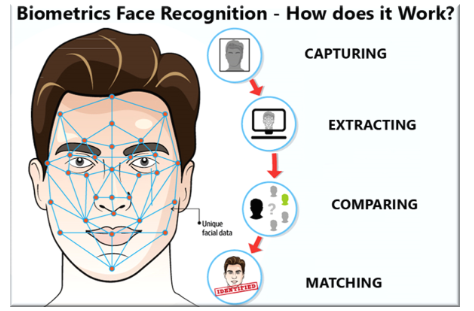Facial Recognition Technology in India (GS Paper 2, Governance)

Introduction
- Recently, the NITI Aayog, the premier public policy think-tank of the Government of India, has called for comprehensive policy and legal reforms to regulate the use of Facial Recognition Technology (FRT) in the country.
- This move addresses growing concerns about privacy, transparency, and accountability.
Proposals to Regulate FRT in India
Current Status of Regulation in India
- Absence of Legal Framework: Currently, India lacks a comprehensive legal framework to regulate the use of Facial Recognition Technology (FRT).
Need for Regulating FRT
- Multifaceted Challenges: FRT presents distinct challenges compared to other technologies due to its ability to capture and process sensitive biometric data remotely. Existing regulations might not adequately address these specific concerns.
- Ensuring Responsible Development: A comprehensive governance framework is essential to mitigate risks and ethical concerns associated with FRT, such as privacy violations, algorithmic bias, and surveillance abuse.
- International Thought Leadership: Proactive regulation can position India as a global thought leader in FRT governance, shaping international discourse and policies.
- Promoting Public Trust: Effective regulation will build public trust in the technology, facilitating its widespread adoption across various sectors.
- Balancing Innovation and Safeguards: The reforms aim to balance promoting FRT innovation with necessary safeguards to protect individual rights and societal interests.
Key Proposals
- Standardizing Liability: Establishing a legal framework to impose liability and define damages for harms caused by FRT malfunctions or misuse, incentivizing responsible development and deployment.
- Ethical Oversight: Creating an independent ethical committee with diverse expertise to oversee FRT implementation, addressing issues of transparency, accountability, and potential bias within the algorithms.
- Transparency in Deployment: Mandating clear and transparent guidelines on the deployment of FRT systems, including public notification and obtaining consent where necessary.
- Legal Compliance: Ensuring FRT systems comply with the Supreme Court's established legal principles in its judgment given in the Justice K. S. Puttaswamy (Retd) vs. Union of India case, which includes legality, reasonability, and proportionality.
Understanding Facial Recognition Technology (FRT)
About
- Algorithm-Based Technology: FRT creates a digital map of the face by identifying and mapping an individual’s facial features, matching it against a database.
Working
- Capture and Reconstruction: The facial recognition system captures facial features through a camera and uses software to reconstruct these features.
- Database Integration: The captured face is stored in a database, which can be integrated with software used for security, banking, etc.
Uses
- Verification: Matching a person's facial map against a database to authenticate their identity (e.g., unlocking phones).
- Identification: Matching a facial map from a photograph or video against a database to identify a person (e.g., law enforcement).
Concerns Regarding the Use of FRT Technology
- Inaccuracy, Misuse, and Privacy Concerns: Misidentification, particularly across racial and gender demographics, and surveillance clash with data privacy and protection objectives.
- Racial and Gender Biases: Disparities in FRT accuracy based on race and gender can exclude deserving candidates and reinforce societal biases.
- Exclusion from Essential Services: Failures in biometric authentication, such as under the Aadhaar system, have excluded individuals from accessing essential government services.
- Absence of Data Protection Laws: Lack of comprehensive data protection laws makes FRT systems vulnerable to misuse, with inadequate safeguards for biometric data.
- Ethical Concerns: FRT raises questions about balancing public safety with individual rights, potential misuse for social control, and suppression of dissent.
FRT Regulation in Other Countries
- European Union (EU): The EU’s AI Act categorizes FRT systems as “high risk” and subjects them to strict compliance requirements, alongside GDPR and the Data Protection Directive.
- UK, US, Canada, and Australia: Regulation of FRT is governed by respective data protection and privacy laws.
Way Forward
- Robust Legal Framework: Establish dedicated laws governing FRT deployment by both public and private actors, clearly defining lawful purposes, emphasizing proportionality, and establishing accountability.
- Ethical Oversight and Governance: Create independent ethical oversight committees to assess FRT deployments, prescribe codes of practice, and ensure compliance.
- Transparency and Data Protection: Mandate public disclosure of FRT deployments and align FRT governance with India’s upcoming data protection framework to ensure robust data protection safeguards.
- Addressing Bias: Develop guidelines promoting fair and non-discriminatory use of FRT, especially in high-stakes applications.
- Global Leadership: Actively participate in international discussions on FRT governance to shape global standards and leverage India’s technological leadership to champion responsible AI development on the world stage.
Conclusion
- The regulation of Facial Recognition Technology in India is crucial to ensure responsible development and deployment while addressing privacy, ethical, and bias concerns.
- A robust legal and ethical framework, along with international collaboration, will enable India to harness the benefits of FRT while safeguarding individual rights and societal interests.


